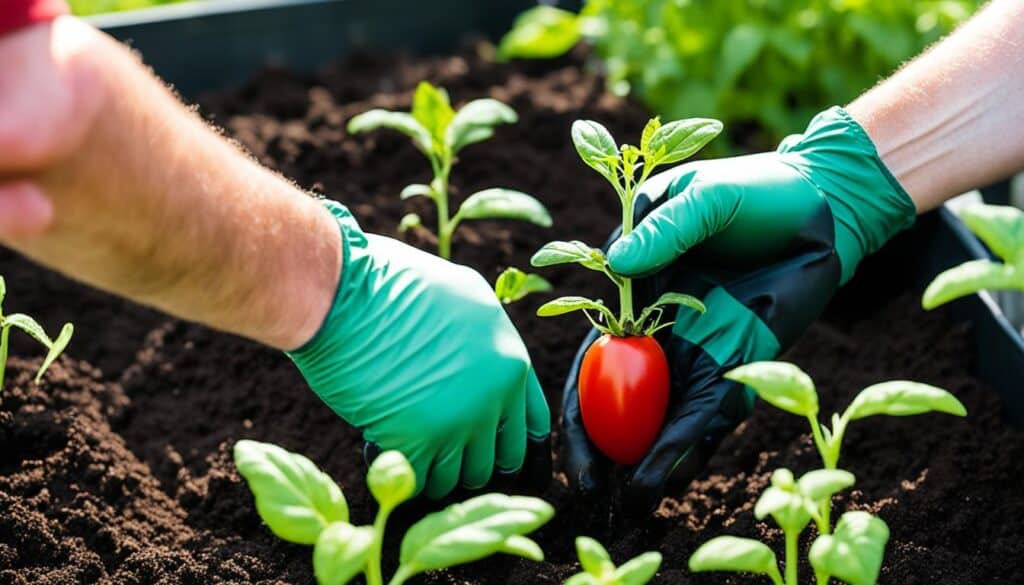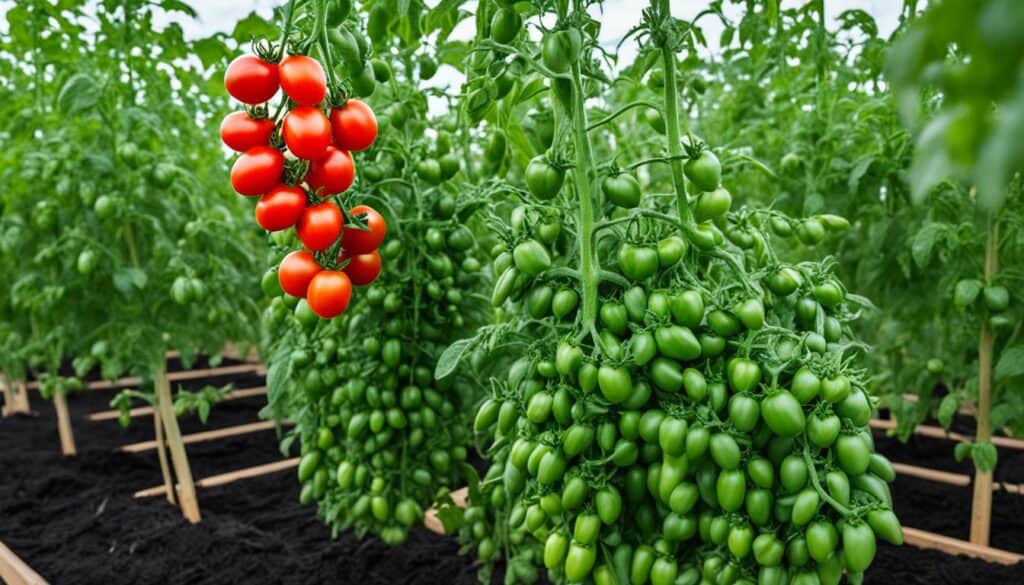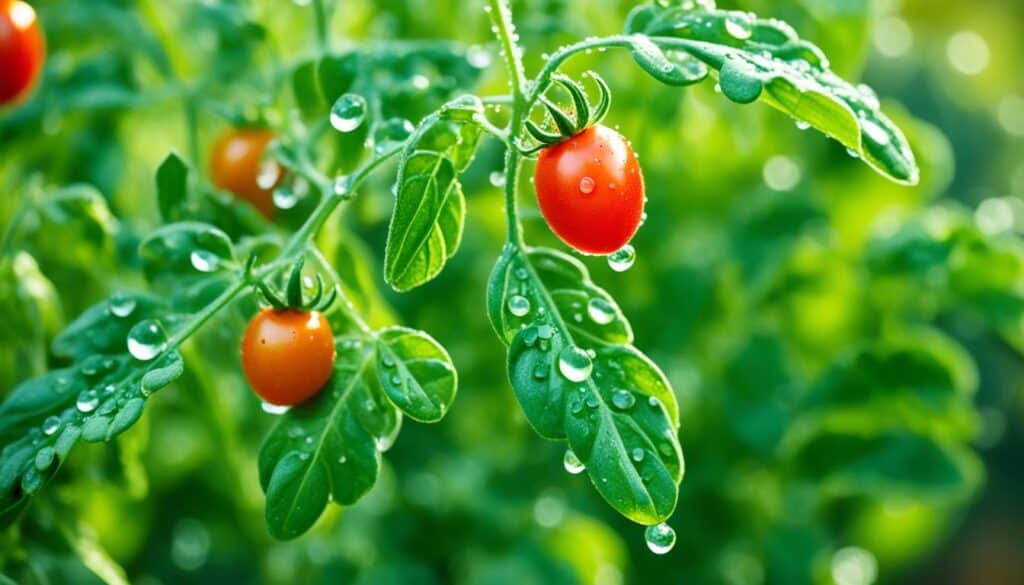Did you know that Amish Paste tomatoes are not only prized for their delicious flavor, but they also have a fascinating history? These heirloom tomatoes, originating from the Amish community in Wisconsin, have become a favorite among gardeners and culinary enthusiasts alike. Their large size and thick, meaty flesh make them perfect for creating rich tomato sauces and pastes. But how can you successfully grow these flavorful tomatoes in your own garden? Let’s explore some tips and tricks that will help you cultivate organic Amish Paste tomatoes and enjoy a bountiful harvest.
Key Takeaways:
- Amish Paste tomatoes are known for their large size and meaty flesh, making them ideal for sauces and pastes.
- They can be grown easily in both greenhouse and outdoor environments.
- Amish Paste tomatoes require a long growing season, well-drained soil, and at least 8 hours of direct sunlight daily.
- Mulching, staking, and proper pruning techniques are essential to support the plants and improve fruit quality.
- They are heavy feeders and should be fertilized with an organic blend rich in phosphorus and potassium.
Seeds or Seedlings
Growing Amish Paste tomatoes offers the option of starting from either seeds or seedlings. Both methods have their benefits, depending on your level of experience and the resources available to you.
If you choose to start from seeds, you should sow them approximately 6 weeks before the anticipated transplanting date. To ensure successful germination, use a well-drained soilless starting mix and maintain a soil temperature between 65-90 degrees F. Keep the soil moist, and within 6 to 12 days, you’ll see the emergence of seedlings.
Starting from seeds allows you to have complete control over the growing process, from the very beginning. It can be a gratifying experience to nurture these tiny seeds into healthy, productive plants.
On the other hand, using seedlings has its advantages, especially if time is of the essence or if you’re a beginner gardener. When transplanting Amish Paste tomato seedlings, it’s important to wait until after the last frost, and ensure that temperatures do not drop below 50 degrees F at night. Select seedlings that are sturdy, short, and dark green, with no signs of legginess or yellowing.
Opting for seedlings offers a head start in the growing process, as they have already established a root system and gained some strength before being transplanted outdoors.
Whether you choose to start from seeds or seedlings, your ultimate goal is to grow robust and healthy Amish Paste tomato plants that will reward you with plenty of delicious fruits.
Comparison of Starting from Seeds and Seedlings
| Starting Method | Advantages | Disadvantages |
|---|---|---|
| Seeds |
|
|
| Seedlings |
|
|
Soil & Growing Needs
Choosing the right soil and providing optimal growing conditions are important for successful cultivation of Amish Paste tomatoes. These tomatoes thrive in well-drained, fertile soil that is rich in organic matter. While they can tolerate slightly acidic soils, they are most productive in a pH range of 6.0 to 6.8.
The type of soil also plays a role in the yield and timing of the harvest. Fertile clays and loams produce the highest yields, whereas lighter soils that drain and warm quickly can provide earlier harvests.
Amish Paste tomatoes require at least 8 hours of direct sunlight daily to reach their full potential. They thrive in warm to hot growing conditions, making them ideal for gardens in the United States.
Tomato plants are heavy feeders and require regular fertilization. Use an organic blend that is rich in phosphorus and potassium to promote healthy growth and yield. Avoid excessive applications of nitrogen, as it can lead to excessive foliage growth and poor fruit set.
When it comes to watering, it is essential to keep the soil evenly moist once flowering and fruiting begin. Moderate watering is recommended, ensuring that the plants do not experience drought stress. Mulching can help retain soil moisture and suppress weed growth, making it a beneficial practice for tomato plants.
It is important to note that Amish Paste tomatoes should not be planted in soil that has recently grown tomatoes, potatoes, peppers, or eggplants. This helps reduce the risk of root diseases that can affect the plants’ health.
Companion planting can also play a role in the success of growing Amish Paste tomatoes. Carrots, onions, chives, garlic, asparagus, roses, and nettle are among the plants that can provide beneficial interactions with tomatoes. However, it is important to keep tomatoes away from members of the Brassicaceae family and other incompatible crops that could hinder their growth.
Now that you understand the soil and growing needs of Amish Paste tomatoes, let’s move on to the next section, where we’ll discuss the process of transplanting your seedlings outdoors.
Transplanting Your Starts Outside
Transplanting Amish Paste tomato seedlings is a crucial step in the growing process. To ensure successful transplantation, it’s important to consider the weather conditions and the readiness of the seedlings. Here are some essential tips for transplanting your Amish Paste tomatoes:
- Timing: Wait until the last frost has passed and the nighttime temperatures consistently stay above 50 degrees F.
- Seedling selection: Choose seedlings that are sturdy, short, and have a healthy dark green color. Avoid seedlings that appear leggy or have yellowing leaves.
- Hardening off: Before transplanting, gradually expose the seedlings to outdoor conditions. Reduce watering and fertilizer to help them acclimate to the change.
- Planting depth: Bury the seedlings deeper than they were grown in containers. This encourages the development of additional roots along the buried stem, promoting a stronger root system.
- Soil selection: Avoid planting Amish Paste tomatoes in soil that has recently grown tomatoes, potatoes, peppers, or eggplants. This helps reduce the risk of root diseases.
- Protection from cold: Use black plastic mulch or row covers to warm the soil and protect the plants from cooler temperatures early in the season.
- Spacing: The spacing for Amish Paste tomatoes depends on the variety. Determinate varieties should be spaced 12 to 24 inches apart, staked indeterminate varieties 14 to 20 inches apart, and unstaked indeterminate varieties 24 to 36 inches apart.
| Transplanting Tips | |
|---|---|
| Wait until the last frost has passed and temperatures stay above 50 degrees F at night | |
| Choose sturdy, short, dark green seedlings | |
| Harden off the seedlings gradually | |
| Plant seedlings deeper, burying the stem below the lowest leaves | |
| Avoid planting in soil previously used for tomatoes, potatoes, peppers, or eggplants | |
| Use black plastic mulch or row covers for early season protection | |
| Follow appropriate spacing based on the variety |
Mulching, Staking & Pruning Tomato Plants
It’s essential to provide proper support and care to your Amish Paste tomato plants to ensure healthy growth and abundant fruit production. Mulching, staking, and pruning are key practices that can significantly enhance the quality and yield of your tomatoes.
When it comes to mulching, it’s recommended to wait until the soil has warmed up before applying mulch around your Amish Paste tomato plants. Mulching helps retain soil moisture and suppresses weed growth, creating a favorable environment for your plants to thrive. For Amish Paste tomatoes, black plastic mulch can be particularly beneficial, as it not only maintains soil moisture but also aids in warming the soil, allowing for more complete fruit development even in less ideal light conditions.
| Mulching Benefits for Amish Paste Tomatoes |
|---|
| Promotes soil moisture retention |
| Suppresses weed growth |
| Helps warm the soil |
| Aids in more complete fruit development |
Amish Paste tomatoes require a consistent supply of moisture, especially once they start flowering and bearing fruit. Therefore, adequate watering is crucial. Additionally, staking and pruning your plants can have a significant impact on fruit quality, cleanliness, and ease of harvest.
Staking involves driving wooden stakes at least 8 to 10 inches deep near the plants and tying the tomato stems to the stakes with soft string or twine. This practice helps support the plants, prevents sprawling, and reduces the risk of fruit rotting on the ground. Pruning is another essential task that involves removing “suckers,” which are stems growing from where the leaf stems meet the main stem. Pruning improves airflow, reduces the risk of diseases, and encourages larger fruit growth.
Here’s a quick guide on staking and pruning your Amish Paste tomato plants:
- Drive wooden stakes approximately 8 to 10 inches deep near the plants.
- Tie the tomato stems to the stakes using soft string or twine in a figure-8 formation, allowing room for stem expansion.
- Remove suckers by gently pinching them off at the base, making sure not to damage the main stem or other branches.
Alternatively, you can also consider using wire mesh cages to provide support to your Amish Paste tomato plants. These cages offer stability and allow the plants to grow upward while keeping them organized.
It’s important to note that staking and pruning may reduce the total yield of your plants but will often result in larger, higher-quality fruits. While these tasks require some time and effort, the benefits they bring far outweigh the labor involved.
Fertilizing & Watering Tomatoes
When it comes to growing Amish Paste tomatoes, proper fertilization and watering techniques are essential for healthy plant development and a bountiful harvest. These heavy feeders require specific care to ensure optimal growth and fruit production. Here are some tips to help you fertilize and water your Amish Paste tomatoes effectively:
Fertilizing
Amish Paste tomatoes benefit from an organic blend that is rich in phosphorus and potassium. Avoid excessive applications of nitrogen, as this can result in excessive foliage growth and poor fruit set. To provide the necessary nutrients, sidedress the plants with a balanced fertilizer when the fruits are about 1 inch in diameter and again when harvest begins. This will support continuous plant growth and encourage the development of plump, flavorful tomatoes.
Watering
Maintaining consistent soil moisture is crucial for the overall health and fruit quality of Amish Paste tomatoes. Avoid allowing the soil to dry out completely between waterings, as this can lead to issues such as blossom end rot and fruit cracking. Drip irrigation is an excellent watering method for these plants, ensuring regular moisture without wetting the foliage. It’s important to provide adequate water during hot and dry periods, as tomatoes are drought-tolerant but still require hydration for optimal growth. However, be cautious with overhead watering, as it can increase the risk of disease and fruit rot.
To maintain the best moisture balance, monitor the soil regularly and adjust your watering schedule accordingly. By keeping the soil evenly moist and providing adequate hydration, you can help your Amish Paste tomatoes thrive and produce their signature large, meaty fruits.
Cross Pollination
In tomato plants, cross pollination can occur when different varieties are planted close together. This happens when pollen from one variety lands on the female part of a blossom from another variety, resulting in hybrid seeds in the fruit. While cross-pollination only affects the seeds within the fruit and can be ignored if you’re not interested in saving seeds, it’s essential to manage cross pollination if you want to maintain a pure tomato variety.
To prevent cross-pollination, there are certain measures you can take. “Bagging” the blossoms with lightweight fabric or using isolation/screening cages can effectively prevent foreign pollen from being introduced. Bagging is a simple technique where the blossoms are covered before they open, ensuring no cross-pollination occurs. This method is particularly important for preserving rare heirloom varieties or specific named varieties.
However, it’s worth noting that cross-pollination can sometimes be desirable for home gardeners looking for interesting variations in their tomato harvest. In such cases, specific measures can be taken to encourage cross-pollination. But for those who wish to maintain the purity of their tomato variety, proper management and prevention of cross-pollination is crucial.
Managing cross pollination in tomatoes can be challenging, especially when aiming to collect large quantities of pure seeds using bagging methods. In such cases, hand pollination techniques may be required to maintain the desired characteristics of a particular tomato variety.
Methods for Managing Cross Pollination in Tomatoes
| Methods | Pros | Cons |
|---|---|---|
| Bagging the blossoms with lightweight fabric | – Effective in preventing cross-pollination – Simple technique to implement |
– Difficult to collect large quantities of pure seeds – Requires manual pollination for seed collection |
| Using isolation/screening cages | – Provides complete isolation from other varieties – Allows natural pollinators to access the blossoms |
– Requires additional setup and maintenance – Limited space for larger plants |
| Hand pollination techniques | – Ensures controlled pollination – Ideal for collecting pure seeds in larger quantities |
– Time-consuming process – Requires manual intervention |
By implementing these methods, home gardeners can manage cross pollination in their tomato plants, ensuring the preservation of specific tomato varieties and achieving desired seed results.
Variety Review – Amish Paste Tomatoes
The Amish Paste tomatoes are a prized variety that originated from the Amish community in Wisconsin. These tomatoes have gained popularity for their exceptional qualities, making them a favorite choice for tomato sauces and pastes. Let’s dive into the characteristics that make Amish Paste tomatoes truly exceptional.
Size and Texture:
Amish Paste tomatoes are known for their large size and thick, meaty flesh. They have an oval shape with a pointed tip and typically weigh between 8 to 12 ounces each. The dense texture of these tomatoes makes them perfect for easily skinning and processing.
Flavor Profile:
When it comes to flavor, Amish Paste tomatoes deliver a delightful combination of sweetness and tanginess. Their well-balanced taste adds depth and character to any dish they’re used in. Whether you’re making sauces, salsas, or salads, the sweet and tangy flavor of Amish Paste tomatoes is sure to please your taste buds.
Growing Characteristics:
The Amish Paste tomato plants are indeterminate, meaning they continue to produce fruit throughout the growing season. They exhibit resilience against many common tomato diseases and boast a high heat tolerance, ensuring a successful harvest. These versatile plants can be cultivated in both greenhouse and outdoor environments, providing flexibility to growers.
Storage and Usage:
Once ripe, the bright red Amish Paste tomatoes can be stored in the refrigerator for a week or two without compromising their flavor or quality. These robust tomatoes are ideal for a variety of culinary applications. From sauces and salsas to salads and sandwiches, you can use Amish Paste tomatoes in numerous recipes that call for a burst of flavor and rich texture.
| Characteristics | Description |
|---|---|
| Size and Shape | Oval shape with a pointed tip, weighing between 8 to 12 ounces each. |
| Flavor | Sweet and tangy flavor, with a dense texture and few seeds. |
| Growing Type | Indeterminate plants that continue to produce fruit throughout the growing season. |
| Disease Resistance | Resistant to many common tomato diseases and high heat tolerance. |
| Suitable Environments | Can be grown in both greenhouse and outdoor environments. |
| Usage | Perfect for making sauces, salsas, and salads. Can be stored in the refrigerator for a week or two. |
Amish Paste tomatoes truly stand out with their exceptional flavor, texture, and adaptability. Whether you’re a seasoned gardener or a passionate cook, these tomatoes are a must-try. With their versatility and fantastic characteristics, Amish Paste tomatoes are sure to add a delicious touch to your culinary creations.
Conclusion
Growing Amish Paste tomatoes can be a fulfilling endeavor for tomato sauce and paste enthusiasts like me. By implementing the tips and tricks shared in this article, gardeners can ensure a plentiful harvest of these delightful heirloom tomatoes.
Amish Paste tomatoes offer a unique, sweet, and tangy flavor that can enhance a variety of recipes, from luscious sauces to refreshing salads. Their large size and dense flesh make them easy to skin and process, making them a favorite among home cooks and chefs alike.
To truly unlock the potential of Amish Paste tomatoes, I encourage you to experiment with different cooking methods and flavor combinations. Whether you choose to grow them in a greenhouse or in your outdoor garden, their abundant yield and versatility in the kitchen will undoubtedly impress.
With proper care and attention, anyone, from beginners to experienced growers, can relish the joys of cultivating and cooking with Amish Paste tomatoes. So why not embark on this flavorful journey and discover the countless ways these tomatoes can add a touch of sweetness to your dishes and delight your taste buds?








Leave a Reply